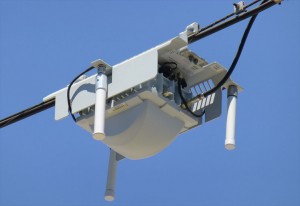 I’ve spent a lot of time and spilled a lot of ink writing about Section 6409(a) of the Middle Class Tax Relief and Job Creation Act of 2012 (H.R. 3630). That’s the poorly conceived and equally poorly written section addressing wireless collocations at some existing wireless sites.
I’ve spent a lot of time and spilled a lot of ink writing about Section 6409(a) of the Middle Class Tax Relief and Job Creation Act of 2012 (H.R. 3630). That’s the poorly conceived and equally poorly written section addressing wireless collocations at some existing wireless sites.
This posting is not about 6409(a).
Rather, in this post I turn my attention to Section 6409(b)(1) of the Middle Class Tax Relief and Job Creation Act of 2012. That section sets out a new federal policy regarding wireless siting on federal property and federal buildings. As we all know, there’s a lot of federal property, and a heck of a lot of federal buildings.
Let’s start with a quick review of 6409(b)(1), which is the meat of the section:
Sec. 6409
. . .
(b) FEDERAL EASEMENTS AND RIGHTS-OF-WAY.—(1) GRANT.—If an executive agency, a State, a political subdivision or agency of a State, or a person, firm, or organization applies for the grant of an easement or right-of-way to, in, over, or on a building or other property owned by the Federal Government for the right to install, construct, and maintain wireless service antenna structures and equipment and backhaul transmission equipment, the executive agency having control of the building or other property may grant to the applicant, on behalf of the Federal Government, an easement or right-of-way to perform such installation, construction, and maintenance.
I’ve recently heard that some members of the public are looking at Section 6409(b) as some sort of Congressional mandate requiring the federal government property be made available for the installation of wireless sites.
Not so.
Section 6409(b) of the Middle Class Tax Relief Act does not require that federal agencies lease their property, buildings, roads, waterways, etc. to anyone, much less to wireless entities. Section 6409(b)(1) makes it clear via one very important word (“may”) that the approval is not mandatory; rather it is permissive and approval may be withheld.
The discretion the federal government reserves to itself is perfectly logical when you think about it. Consider, for example, national security and operational reasons why Congress would not want 6409(b) to require wireless siting on federal property.
Look at who is permitted to apply for such an easement under 6409(b)(1), including any: “…executive agency, a State, a political subdivision or agency of a State, or a person, firm, or organization”. Virtually anyone (and I mean anyone) can apply to access federal property to install a wireless site.
Yet, would anyone with a straight face suggest that a foreign government (an “organization” within the meaning of the Section) could compel the National Security Agency to allow it to put equipment and antennas on top of the NSA headquarters building at Fort Meade?
Similarly, would anyone reasonably suggest that a secured research facility operated by a federal agency must open access to its property to allow for the installation and operation of antennas that might cause facility security concerns, or interfere with sensitive experiments?
To torture this discussion just a bit more, would anyone actually believe that Section 6409(b) would compel the installation of wireless antennas within the National Radio Quiet Zone at the National Radio Astronomy Observatory (NRAO) in Green Bank, WV or at the radio receiving facilities for the United States Navy in Sugar Grove, WV?
(Huh? You didn’t know there was a place in the U.S. where the only public telephones are pay telephones, and where government agents will hunt you down for installing a Wi-Fi at your home or for using a cell phone? See: http://www.gb.nrao.edu/nrqz)
To all of the above, the rational answer is an obvious, ‘Of course not.’
At the end of the day, the federal government has created a general policy…but absolutely no requirement…that wireless facilities be allowed on federal property and buildings on a fee-basis, and within reasonable limits to be determined by each agency and at each location. Logically, this would also allow the federal government the right to exclude wireless facilities at any federal location for practically any valid reason.
Here’s an interesting question and wrinkle regarding wireless siting outside of the U.S. territorial limits. Does Section 6409(b)(1) allow a wireless firm, whether foreign or domestic, to apply to siting on U.S. federal lands and buildings physically located in other countries? For example, would 6409(b)(1) open the door for Vodafone U.K. to apply put a cell tower on the grounds of the U.S. Embassy, located on prime real estate at 24 Grosvenor Square in London?
Section 6409(a) is a mess.
Section 6409(b)(1) joins the ranks of 6409(a).
Jonathan

 I’m very pleased to announce that Kramer Telecom Law Firm’s Associate Counsel, Christy O’Berry received word late yesterday that she has passed all of the required examinations, and is now officially licensed as a Professional Engineer in the State of California.
I’m very pleased to announce that Kramer Telecom Law Firm’s Associate Counsel, Christy O’Berry received word late yesterday that she has passed all of the required examinations, and is now officially licensed as a Professional Engineer in the State of California.